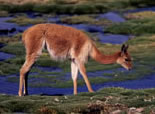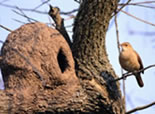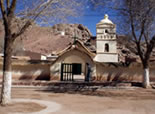Argentina
- Argentina
- Iguazú Atlantic rainforest
- The Pampas
- Iberá Wetlands
- The Andes Cloudforest and Altiplano
- Patagonia
- The Chaco woodlands
|
In the southern part of the American continent, Argentina extends from the tropic of Capricorn to the cold of southern Patagonia. The imposing Andes Mountains range extends down the spine of South America and adds a further gamut of climates and vegetation types. In the north, exuberant montane or cloudforests, known as Yungas, climb the slopes to tree-line at the high desert plateaus, while the most beautiful temperate woods cloak the glacial landscapes of the southern reaches. Vast savannahs and impenetrable thorny woods of the Gran Chaco occupy the north central region, giving way eastwards to the subtropical Atlantic rainforests where the famous Iguazú waterfalls spills into the Paraná River. In the central part of Argentina, the well-known Pampas grasslands, give way to the desolate steppes of Patagonia in the distant south. To the east, the nutrient rich Atlantic Ocean harbours Southern Right Whales and thousands of albatross. Nature lovers from all over the world are always very favourably impressed by the marvellous attention given to them by our cosmopolitan and very friendly people, our tango, excellent wines and delicious cuisine, as well as the “best steaks in the world”. |
|||
|
|||
|
Endemic birds of Argentina | Endemic Breeders in Argentina | Near Endemics of Argentina ENDEMIC BIRDS: White-headed Steamer Duck, Hooded Grebe, Moreno s Ground Dove, Sandy Gallito, White-browed Tapaculo, Cordoba Cinclodes , Olrog s Cinclodes, White-throated Cacholote, Steinbach s Canastero, Patagonian Canastero, Rusty-backed Monjita, Salinas Monjita, Yellow-striped Brush-Finch, Carbonated Sierra-Finch. ENDEMIC BREEDERS: Olrog s Gull, Dinelli s Doradito, Lesser Shrike-tyrant, Black-crowned Monjita, Hudson s Black-Tyrant, Chaco Pipit, Cinnamon Warbling-Finch. NEAR EMDEMICS (90% or more of their distribution is in Argentina): Elegant Crested-Tinamou, Patagonian Tinamou, Dot-winged Crake, Band-tailed Earthcreeper (Eremobius), Tucuman Mountain- Finch. |
Country Hightlights
| Subtropical northeast Argentina is unique in its biodiversity. Here the famous Iguazú falls thunder over a 400 m (240 ft) drop, surrounded by the imposing Atlantic forest which extends southwards through most of Misiones Province. There are numerous nature reserves where the better stands of this endangered forest are safeguarded, Iguazú National Park being one of the better examples, together with the Urugua-í and Moconá Provincial Reserves. These forests are home to two of the largest mammals – the Tapir and the Jaguar, but also Brown Capuchin Monkeys, Agoutis, and three species of Brockets and Coatis. In this area, it is possible to find some 400 species of birds which include the Solitary Tinamou, Black-fronted Piping-Guan, Great Dusky Swift, Red-ruffed Fruitcrow, Spot-backed Antshrike, five species of toucans, and numerous woodpeckers, manakins, tanagers, and hummingbirds. In the mountainous center of the province, one can find vestigial stands of the formerly extensive Araucaria woods, centenarian specimens where Vinaceous-breasted Parrot, Araucaria Tit-Spinetail, and Canebrake Groundcreeper live almost exclusively. Further south, in the province of Corrientes, the forests give way to savannahs locally known as “campos”, where one finds the immense system of the Iberá marshes, a vast wetland surrounded by grassland, savanna, and the thorny woods of the Espinal. A million hectares of the Iberá marshes are protected as a provincial nature reserve. Here the Marsh Deer, Capybaras, and two species of Cayman, as well as the Neotropical Otter, Yellow Anaconda, and endangered Manned Wolf all live. Some species of birds are really spectacular such as the Giant Wood-rail, Southern Screamer, Anhinga, Savanna Hawk, Jabiru Stork, Black-capped Donacobius, White-headed Marsh-Tyrant, Yellow-rumped Marshbird and Scarlet-headed Blackbird. Secretive species that inhabit the denser and quieter parts of these marshes include Pinnated and Stripe-backed Bitterns, Rufous-sided and Yellow-breasted Crakes, Azure Gallinules and Crested Doradito. Here too we may encounter several species of rare or endangered birds such as the Sickle-winged Nightjar, Saffron-cowled Blackbird, Sharp-tailed Tyrant, Back-and-white Monjita, Strange-tailed Tyrant, Ochre-breasted Pipit, and several species of seedeaters, such as Rufous-rumped, Marsh, and Chestnut. |
|||
|
Country Hightlights
|
From Buenos Aires, the capital city and main entrance point to the country, one can visit many protected natural areas where the typical native Pampas flora and fauna exist. This famous region is known for its vast plains covered with grasslands interspersed with wetlands. In fact there is a lot more to the region: near Buenos Aires we can explore the native “Espinal” woodlands, the delta of the Paraná River, mudflats on the shores of the River Plate and the Atlantic sea-coast. Just 15 minutes from any hotel one can visit the Costanera Sur Nature Reserve, some 360 hectares (890 acres) of grassland, lakes and patches of woods. This reserve is an excellent introduction to the local fauna and flora where at least 50 species of birds can be seen in a brief visit: Coscoroba and Black-necked Swans, three species of coots, several waders and many ducks such as the Black-headed Duck; passerines here include the Spectacled Tyrant, Masked Gnatcatcher, Black-and-rufous Warbling-finch; other wildlife in the reserve includes the Coypu (erroneously known as Nutria), Cavies (the origin of Guinea-pigs), the small Red Water-possum, Tegu Lizard and Hillary’s Side-necked Turtle. The Otamendi Nature Reserve, part of the national park system and nearly 3.000 hectares (7400 ac) big, is a short ride of 68 Km (42 mi) north-west from Buenos Aires. Samples of the habitats bordering the Paraná River are here protected: gallery forest, marshes and reed-beds, grassland and Hackberry woods are all found here. The area is special for several species of birds such as the Curve-billed and Straight-billed Reedhaunters, the Checkered Woodpecker, Chicli Spinetail, Red-rumped Warbling-finch and Diademed Tanager. In the wetter areas the Giant Wood-Rail may be seen; Snail Kite, Long-winged Harrier and the Scarlet-headed Blackbird are common over the open marshes and reedbeds. Just across the Paraná River we can explore the delta habitats and thorny Prosopis woods of Entre Ríos province, near Ceibas, some 150 Km (93 mi) from Buenos Aires. In this region one can find an impressive array of birds, with Ringed Teal, White-fronted Woodpecker, Scimitar-billed Woodcreeper, Brown Cacholote, Short-billed Canastero, Lark-like Brushrunner, Rusty-collared Seedeater and Xenopsaris amongst others. Working south out of the capital city we encounter the real Pampas of Argentina, where huge stands of Pampas grass and a series of marshes surround the sea-side town of San Clemente. Here one is ideally situated on the shores of the Atlantic Ocean, near several different eco-systems. The Punta Rasa reserve forms a long peninsula, separating the sea from the estuary and tidal River Plate mud-flats. On the shores we will encounter hundreds of terns and Black Skimmers, Olrog’s Gull and several shorebirds which visit the site during the summer – American Oystercatcher, Hudsonian Godwit, Greater and Lesser Yellowlegs, White-rumped Sandpiper, Red Knot and Golden Plover. Driving a short distance inland we visit some estancias and explore the grasslands and marshes where such interesting species as the Greater Rhea, the South American Painted Snipe, Southern Screamers and Spotted Nothura are found. The Pampas has several species of mammals; chief amongst them is the much endangered Pampas Deer, here in one of its last strong holds. Yet further south is Bahía Blanca, ideally situated to visit the ecotone between the Pampas and the thorny woodlands of the Espinal. This is the area for what is perhaps the most endangered species in the country, the Pampas Meadowlark, and it is also a good area to find another endangered species, the Yellow Cardinal. Here too we see one of the most enigmatic species, the Pampas Pipit. |
|||
|
Country Hightlights
|
The Iberá Wetlands (in Spanish: Esteros del Iberá) are a mix of swamps, bogs, stagnant lakes, lagoons, and courses of water in the center-north of the province of Corrientes, Argentina. The wetlands are one of the most important freshwater reservoirs in South America and the second-largest wetland in the world. The Guaraní people originally populated Iberá and named it after the shining waters of the main lagoon. In Guaraní, ý berá translates to bright water. Iberá National Park is one of Argentina’s newest national parks and is located in the northeast province of Corrientes. The park was created in 2018 and together with the Iberá provincial park makes a conservation area of 1,324,5oo hectares. These wetlands feature some of the country’s best wildlife watching and criollo traditions from its unique Spanish and Guaraní heritage. The wetlands are home to over 4,000 species of flora and fauna including over 350 species of birds and a variety of mammals such as capybaras, marsh deer, giant anteaters, pumas, and maned wolves. The wetlands are also home to several localized and endangered species such as Chaco Eagle, Yellow Cardinal, Strange-tailed Tyrant, Black-and-White Monjita, Saffron-Cowled Blackbird, and numerous species of Seedeaters in the genus “Sporophila”. Waders and herons of all kinds abound in the area, including Maguari and Jabiru Stork, Stripe-backed and Pinnated Bitterns, Plumbeous Ibis, Roseate Spoonbill, Giant Wood-Rail, Rufous-sided Crake, and many more. |
|||
|
Country Hightlights
|
There is no region in Argentina with such diversity of life forms as the northwest. While exploring the mountains we cannot fail to notice the rapid transition of habitats from dry woodlands to the humid Cloudforest, to grasslands and high mountain deserts. |
|||
|
Country Hightlights
| At the southern end of the continent we find one of the most remote and underpopulated regions on earth. Patagonia has not changed much since it was first seen by Magellan, in 1520. Later such notable visitors as Charles Darwin and William Henry Hudson walked its shores and explored the region. The vast steppe, unending sea-coasts and dense woods of Southern Beeches in the Andes make the region a real Mecca for lovers of the nature of wilderness. Our first contact with Patagonia will probably be the Valdés Peninsula. Standing off the continent and only joined to it by a narrow isthmus, this is a real wildlife sanctuary and has been recognized as such by its declaration as a World Heritage Site by UNESCO. The steppes are home to many birds and animals such as the Guanaco, Maras (Patagonian Cavies – but gigantic) and Lesser Rheas while, on the coast, multitudes of South American Sea-lions, Southern Elephant Seals, cormorants of four species, Magellanic Penguins all congregate during their breeding seasons. Here too one can see the endangered Southern Right Whales on their breeding grounds off the shores, or take a boat trip to get a closer look at them. Some bird specialties of the area are the Elegant Crested Tinamou, the Band-tailed Earthcreeper, Patagonian Yellow-Finch as well as the endemic Chubut Steamer-Duck, White-throated Cacholote, Patagonian Canastero, Carbonated Sierra-finch and Rusty-backed Monjita. In northern Patagonia is the town of San Antonio Oeste, well within the region of the Creosote bush (Larrea spp), preferred habitat for many of the endemic species and local specialties. It is home to Sandy Gallito, Cinnamon Warbling-Finch, Black-crowned Monjita, Hudson’s Black-Tyrant and the spectacular and rare Yellow Cardinal. At the same latitude, Bariloche in the foothills of the Andes has Swiss alpine architecture in the setting of lakes, mountains and woods of Nahuel Huapi National Park, the first park in the country, created in 1903. Bariloche is the perfect base for exploring three habitats – Southern Beech woods, the western grassy steppe and the high mountains. On day excursions we can find the Chilean Pigeon, Striped Woodpecker, Green-backed Firecrown, Des Murs’ Wiretail, Black-throated Huet-huet, Chucao Tapaculo and Patagonian Tyrant. Flying to El Calafate in the extreme south-west of continental Argentina, we are now in Santa Cruz province and from here we explore the remoter parts of Patagonia. A short drive towards the mountains takes us to one of the most spectacular places on earth – the snout of the Moreno Glacier in Los Glaciares National Park. The South American Grey Fox, Andean Condor, Upland Goose, Black-faced Ibis, Spectacled Duck and much more are to be seen there. For the daring, a longish drive along famous Route 40 takes us to Strobel Lake Plateau, our starting point from where we search for one of the world’s most special birds, the Hooded Grebe. Almost since its discovery in 1974 it seemed to withdraw from accessible places and the traditional circuits, but our team of guides has located a lagoon where it nests; this site can be reached in a vehicle. On the same expedition we also made one of the most important, recent ornithological discoveries in Argentina, the Austral Rail. The area also affords good opportunities to see the Patagonian Tinamou. Patagonia itself continues southward onto the island of Tierra del Fuego, and Ushuaia, the southernmost city in the world. From here we explore the glaciers and mountains, Southern Beech forests and the waters of the Beagle Channel, in all of which we will find a good variety of wildlife. Magellanic and Imperial Cormorants, Spectacled Duck, White-throated Caracara, Austral Pygmy-Owl, White-throated Treerunner and Magellanic Tapaculo are but some of the species inhabiting these latitudes. A hike above the tree-line gives us a chance at the White-bellied Seedsnipe, while a pelagic trip along the Beagle Channel yields South American Sea-lions, Southern Fur-seals, Gentoo Penguins, Magellanic Diving-Petrels, Black-browed Albatross and lots more. |
|||
|
Country Hightlights
| North-central Argentina is covered by this unique biogeographic formation characterized by a succession of deciduous woods, savannahs, and palm groves. In the central areas, the Quebracho tree (Shinopsis spp) dominates, with its incredibly hard wood, while in the arid western and southern reaches this is replaced by the Monte, an ecosystem endemic to Argentina dominated by Creosote Bushes (Larrea spp). Some of the most spectacular species live in these regions: Crowned Eagle, Chaco Owl, Red-legged Seriema, Chaco Chachalaca, Spot-backed (Chaco) Puffbird, Great Rufous Woodcreeper, Stripe-backed Antbird, and Many-coloured Chaco-Finch are but a few examples of birds in this rich biome. In the drier west and south the Black-legged Seriema, the endemic Steinbach’s Canastero, Burrowing Parrot, and many more, while in the savannahs and marshes of the wetter east and north, we find an array of completely different species such as the Whistling Heron, Jabiru Stork, Plumbeous Ibis, Pale-crested and Golden-green Woodpeckers, Purplish Jay, and Red-crested Cardinal. Most of the larger mammals of South America are found here also, including the Brown Brocket, peccaries, the South American Tapir, and the elusive Puma, as well as the conspicuous Black Howler Monkey, Crab-eating Raccoon, Red Brocket, and armadillos of several species. In the geographic center of the country rise the Cordoba Hills, separated from the Andes by some 320 Km (200 mi) of salt flats, known as Salinas. The region has acted as a true island for speciation and is home to several endemics both with elevation and in the adjacent lowlands. Such is the case of the Sierran Meadowlark, Cordoba Cinclodes, Olrog´s Cinclodes, and Salinas Monjita, two of the most sought-after birds of the region. Here too Andean Condors patrol the skies; small jewels like the Red-tailed Comet and the Olive-crowned Crescent-chest are but a few examples of what can be found in the area. Dense stands of Chaco vegetation support an amazingly rich assortment of birds which includes Brushland Tinamou, Spot-winged Falconet, Black-bodied Woodpecker, Chaco Owl, Scimitar-billed Woodcreeper, and the Black-and-chestnut Warbling-Finch. |
|||
|



